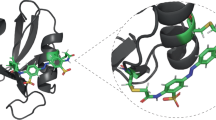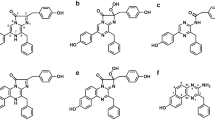Abstract
Ca2+, involved in almost all processes of cell life, mediates its activity through reversible interaction with specific binding sites in proteins. Although several Ca2+-dependent activities are known, many of the proteins responsible remain unidentified. Here we describe the synthesis, purification, characterization and potential uses of a new Ca2+-like reagent, azido ruthenium (AzRu), which can be photoactivated. AzRu strongly inhibits Ca2+-dependent activities. AzRu can be used to probe proteins in solution or embedded in membranes. AzRu has no effect on Ca2+-independent or Mg2+-dependent activity. After exposure to ultraviolet irradiation, AzRu binds covalently and specifically to Ca2+-binding proteins, thus providing a new approach for identifying and purifying Ca2+-binding proteins, for characterizing their Ca2+-binding sites and for exploring previously unknown Ca2+-dependent processes. In this protocol we also include a description of the preparation of [103Ru]AzRu, which can be used for labeling Ca2+-binding sites in proteins and identifying previously unknown Ca2+-binding proteins. The preparation of AzRu takes approximately 2–3 days.
This is a preview of subscription content, access via your institution
Access options
Subscribe to this journal
Receive 12 print issues and online access
$259.00 per year
only $21.58 per issue
Buy this article
- Purchase on Springer Link
- Instant access to full article PDF
Prices may be subject to local taxes which are calculated during checkout





Similar content being viewed by others
References
Berridge, M.J., Lipp, P. & Bootman, M.D. The versatility and universality of calcium signalling. Nat. Rev. Mol. Cell Biol. 1, 11–21 (2000).
Carafoli, E. The ambivalent nature of the calcium signal. J. Endocrinol. Invest. 27, 134–136 (2004).
Miyazaki, S., Shirakawa, H., Nakada, K. & Honda, Y. Essential role of the inositol 1,4,5-trisphosphate receptor/Ca2+ release channel in Ca2+ waves and Ca2+ oscillations at fertilization of mammalian eggs. Dev. Biol. 158, 62–78 (1993).
Buonanno, A. & Fields, R.D. Gene regulation by patterned electrical activity during neural and skeletal muscle development. Curr. Opin. Neurobiol. 9, 110–120 (1999).
Berridge, M.J. Calcium signalling and cell proliferation. Bioessays 17, 491–500 (1995).
Gao, B. et al. Functional properties of a new voltage-dependent calcium channel α2δ auxiliary subunit gene (CACNA2D2). J. Biol. Chem. 275, 12237–12242 (2000).
Benzaquen, L.R., Brugnara, C., Byers, H.R., Gatton-Celli, S. & Halperin, J.A. Clotrimazole inhibits cell proliferation in vitro and in vivo. Nat. Med. 1, 534–540 (1995).
Haverstick, D.M., Heady, T.N., Macdonald, T.L. & Gray, L.S. Inhibition of human prostate cancer proliferation in vitro and in a mouse model by a compound synthesized to block Ca2+ entry. Cancer Res. 60, 1002–1008 (2000).
Nie, L., Mogami, H., Kanzaki, M., Shibata, H. & Kojima, I. Blockade of DNA synthesis induced by platelet-derived growth factor by tranilast, an inhibitor of calcium entry, in vascular smooth muscle cells. Mol. Pharmacol. 50, 763–769 (1996).
McConkey, D.J. & Orrenius, S. The role of calcium in the regulation of apoptosis. Biochem. Biophys. Res. Commun. 239, 357–366 (1997).
Nelson, M.R. & Chazin, W.J. Structures of EF-hand Ca2+-binding proteins: diversity in the organization, packing and response to Ca2+ binding. Biometals 11, 297–318 (1998).
Israelson, A., Abu-Hamad, S., Zaid, H., Nahon, E. & Shoshan-Barmatz, V. Localization of the voltage-dependent anion channel-1 Ca2+ binding sites. Submitted.
Laemmli, U.K. Cleavage of structural proteins during the assembly of the head of bacteriophage T4. Nature 227, 680–685 (1970).
Israelson, A., Arzoine, L., Abu-hamad, S., Khodorkovsky, V. & Shoshan-Barmatz, V. A photoactivable probe for calcium binding proteins. Chem. Biol. 12, 1169–1178 (2005).
Gincel, D., Zaid, H. & Shoshan-Barmatz, V. Calcium binding and translocation by the voltage-dependent anion channel: a possible regulatory mechanism in mitochondrial function. Biochem. J. 358, 147–155 (2001).
del Arco, A. & Satrustegui, J. Identification of a novel human subfamily of mitochondrial carriers with calcium-binding domains. J. Biol. Chem. 279, 24701–24713 (2004).
Gregersen, H.J., Heizmann, C.W., Kaegi, U. & Celio, M.R. Ca22+-dependent mobility shift of parvalbumin in one- and two-dimensional gel-electrophoresis. Adv. Exp. Med. Biol. 269, 89–91 (1990).
Acknowledgements
This research was supported by a research grant from B.G. Negev Technologies.
Author information
Authors and Affiliations
Corresponding author
Ethics declarations
Competing interests
The authors declare no competing financial interests.
Rights and permissions
About this article
Cite this article
Israelson, A., Zilberberg, N. & Shoshan-Barmatz, V. Azido ruthenium: a new photoreactive probe for calcium-binding proteins. Nat Protoc 1, 111–117 (2006). https://doi.org/10.1038/nprot.2006.18
Published:
Issue Date:
DOI: https://doi.org/10.1038/nprot.2006.18
This article is cited by
Comments
By submitting a comment you agree to abide by our Terms and Community Guidelines. If you find something abusive or that does not comply with our terms or guidelines please flag it as inappropriate.



